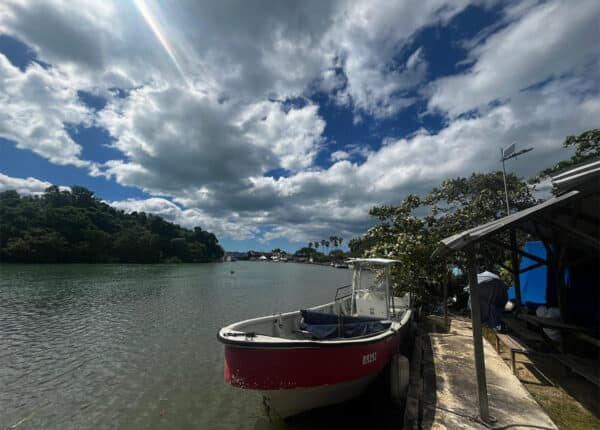Haiti: Where Did the Money Go? An Interview with Michele Mitchell
Above: a camp in Port-au-Prince (Photo: Leslie Owen)
By Alexander Britell
The aftermath of the devastating earthquake that rocked Haiti on Jan. 12, 2010 saw waves of aid workers pouring into the country, backed by billions in aid funds. But exactly what happened to a significant portion of that money, and how it was disbursed, remains unclear, according to award-winning journalist and author Michele Mitchell, who tackles the subject in her new documentary, Haiti: Where Did the Money Go? After several trips the country, and visits to hundreds of camps, Mitchell says the conditions have actually deteriorated. Mitchell, a former investigative correspondent for NOW with Bill Moyers and political anchor for CNN Headline News, is now the executive editor of film for independent media company Film@11. To learn more about the film and her work in Haiti, Caribbean Journal talked to Mitchell about the conditions in Haiti’s camps, the lifestyles of aid workers in the country and the lessons for those considering donating money for relief efforts.
How did this project come about?
I was trying to learn French, and when the earthquake happened, my teacher happened to be Haitian – and she had just come back from a trip to Haiti. She said the conditions hadn’t changed, and she started talking about how there were more traffic jams, with big white trucks. This made me remember some of the other places I’d been in the world – multiple war zones, places where there are very poor people and NGOs trying to help them. There were a few things that were universal, and one of them was the traffic jams of big, white vehicles. So I said, “why is this happening again?” So I started researching to find out what happened to the money. I went to Haiti in November 2010, and was absolutely shocked at what I saw. So I ended up doing a web series called Haiti: Where did the Money Go? – it was five episodes of 10 minutes each, and that came out in January of this year. Based upon that web series, we decided to do the documentary, and as part of that process we went back to Haiti, and walked through the same camps, 10 months after our first trip. This was after the NGOs, like the Red Cross and Catholic Relief Services – told us they’d been spending the money. So when I went back the second time, they were very proud of the work they had done, and I was even more shocked the second time than I had been the first.
What were the conditions like on the ground in the camps when you visited?
It was almost implausible for me that the conditions could get worse, because they were so bad the first time I went. The smell is just unbelievable – in the film, they catch me almost throwing up. It’s almost indescribable what it felt like. You’ve got thousands and thousands of people sharing three toilets or six toilets – so you can imagine what it smells like. The tents are very close together, and there’s not a lot of water to wash with, let alone to drink. So the level of squalor was implausible, and all I could think about was the $1.4 billion donated by half of all American households – that’s an extraordinary number. It’s a lot of money, and a lot of people who had good intentions – but the fact that Haitians were living in conditions like this was shocking to begin with. To go back 10 months later and see that the conditions had deteriorated – it was like being at the bottom and going a level below that. It was Dante’s Inferno, set in the tropics.
What are the major takeaways from the film about the way aid organizations conduct themselves in Haiti?
First of all, what’s happening in Haiti with this relief effort is not specific to Haiti. That is one thing I hope people really understand. This scenario has played out in multiple disaster zones, and it also plays out in war zones. This is the way that the aid world conducts itself – and can conduct itself. There are no regulations — it’s basically peer pressure. Some of the aid organizations are really good. I don’t want people to stop giving money. The point is to give wisely. The are ones that do a good job – and I will give a shout-out to Oxfam, to Doctors Without Borders, to name two big ones, and some similar ones that are fantastic. But they are very stringent about how they conduct themselves, they do internal investigations, they publicize their mistakes. Most NGOs do not do that. The single-biggest problem is that there’s no accountability, and without that they don’t have to have transparency. We have literally no idea how this money has been spent.
It was Dante’s Inferno, set in the tropics.”
What surprised you the most?
The camps spring up wherever they can go – often in parks. In a place called Place Boyer, right across the street from this camp, there are several, very nice expensive restaurants. And I would watch the aid workers drive up into the restaurants. There’s a scene in the movie where I’m reading out the wine list – there’s a Bordeaux for $72, and the menu lists a New York steak for $34 dollars, or a lobster salad for $15.50 – that’s expensive for anywhere – even in New York that’s expensive. But to have people eating like that, and drinking and partying it up … no one wants to say that people shouldn’t have a nice meal from tie to time, but when the people you’re trying to help are directly across the street, I was very curious about what reason they would give me about why they were there. It sends a bad message to the very people you’re supposed to be helping. In one scene, I ask the Head of Mission for CRS, saying, “are you guys aware of the fact that this might be the wrong image? Especially when the people you’re supposed to be helping are across the street?” And he basically said, they’ve got to understand that people are going to want to relax and they’re going to want to eat, and I found that to be surprising.
To have people eating like that, and drinking and partying it up … no one wants to say that people shouldn’t have a nice meal from tie to time, but when the people you’re trying to help are directly across the street, I was very curious about what reason they would give me about why they were there.”
Was were the major trends you saw among the aid workers?
I want to be clear – there are some very hard-working aid workers. I saw wonderful work being done by Oxfam, by something called Global DIRT, by We Advance. But those were NGOs with very specific missions. In the case of Oxfam, they were specifically concerned about sanitation. They were exhausted, and working like crazy to prevent cholera from entering Port-au-Prince. And the Global DIRT guys had just come from helping out with the cholera epidemic, so they were doing incredibly hard work. But often, there were other groups who were maybe not as specific in their mission, and those were the people who looked busy driving their trucks. They’re in these compounds, if you will, but their effectiveness was, I think, the gap of whether they were effective with the money that’s been given. That was the most enlightening part. Because they were handling, in some cases, tens of millions of dollars, in the case of some of the big ones, and how that money is being used? Clearly, they’re not getting the most bang for their buck.
Talk about the research and work process for this project.
We went back two times [to Haiti], and each time we shot for a little over a week. In that time, we walked through well over 100 camps. Some of them were very large, some of them were very small. It’s important note that one of the problems with the relief effort in Haiti is the fact that nobody knows exactly how many people need to be helped, and the reason for that is that there are official camps, the camps that the UN recognizes and that receive services from NGOs, and there are unofficial camps. Those 10,000 people that are in unofficial camps are not recorded by the UN. So as far as the UN is concerned, they don’t exist. The UN does not count people in camps of fewer than 500 – so there are camps that are basically crammed into alleys, up against churches, in some cases lining the streets where the NGOs themselves are housed. And those people aren’t counted either. So when you hear this figure, that 1.5 million people left their homes and 600,000 remained homeless, we don’t even know if that 600,000 figure is correct.
What was the sentiment about aid workers among Haitians you spoke to?
The first time I went to Haiti, which was November 2010, they were not as critical. They were frustrated. I heard a lot of frustration. But they were surprised to find themselves still in camps at the 10-month mark. At the 20-month mark, it was very different – there was a lot of hostility [toward them]. People who I had talked to were not happy to see me the second time I came back. They said, “we have people coming here all the time to talk to us, and nothing ever happens.” And every single time I asked them if they had a question for the aid organizations, the number one thing they said was “we want to know what they did with the money and why they didn’t help us.” It is true that it is logistically very difficult for these NGOs to help every single person.
There would be camps where there was soap, but no water. At another camp, an NGO came where they desperately needed food, and what the NGO passed out were condoms.”
But it’s a very good question, when you have tens of thousands of people in the camps who have received zero services. There is a system, the UN cluster system, which is an effort to coordinate the relief effort. But there were very few Haitian involved in that. No one is asking, “Wheat do you need? How can we help you?” There would be camps where there was soap, but no water. At another camp, an NGO came where they desperately needed food, and what the NGO passed out were condoms. They’ve been sitting in these camps for 20 months, and there is nothing to do – there are no jobs – it’s very difficult for them to help themselves at this point. They’re kind of in a purgatory situation. So they were very critical of the relief effort – A Haitian leader told me that the NGOs were destroying the country, and they were certainly not happy to see me again and to have to give me this kind of an update.
Did you see progress on the economic front?
The short answer is no. I know the Clinton Bush Haiti Fund has donated money to help create this luxury hotel [the Oasis], which should provide some jobs. I have heard of other efforts, and I don’t want to say that I didn’t see some progress in the camps – I did see some transitional shelters being built. So there is some progress, but when I say it, that word has to be taken in the loosest possible way. So even though I saw transitional shelters up in one camp, they were still woefully underserved as far as latrines go, so they still had all the same health issues. There’s a rise in tuberculosis cases now. It’s getting worse.
What is the lesson from this film?
The people on the ground really are trying to do a good job. A lot of the issues are with the system itself – the system of the aid business. People shouldn’t stop giving, but you should give wisely, and you should hold organizations accountable. Because the only accountability that these groups have is to us the donors, so when I talk to people, they’d say, “who do I know whom to give to?” What I usually say is that you should do a lot of research to figure out where you want to donate – to see what kind of organization you’d like to support, so you’re not just reacting to the pain you see on TV, like “text 77 to earthquake victims in Japan.” If you have an ongoing relationship with an aid organization when a disaster happens, you will know how your money is being deployed. I will tell you this much – even though I was really shocked at what I discovered in terms of how this worked, it has not made me stop giving my own money to organize. But you can bet I do a lot more research before I write that check.
Haiti: Where Did the Money Go?, presented by Oregon Public Broadcasting, will premiere on public television stations nationwide on Jan. 10.







